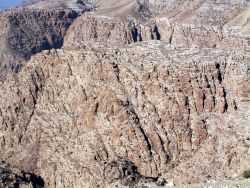Sela (Edom)
| Sela' السلع | |
|---|---|
| Village | |
 | |
 Sela' | |
| Coordinates: 30°45′0.78″N 35°43′35.97″E / 30.7502167°N 35.7266583°ECoordinates: 30°45′0.78″N 35°43′35.97″E / 30.7502167°N 35.7266583°E | |
| Country | Jordan |
| Province | Tafilah Governorate |
| Department | Busaira Department |
| Founded | 1100 B.C. |
| Time zone | GMT +2 |
| • Summer (DST) | +3 (UTC) |
| Area code(s) | +(962)3 |
Sela (Arabic: السلع, Hebrew: סֶּלַע, transliteration Sela‛, meaning rock; Arabic: as-Sala‛; Greek: πέτρα; Latin: petra) was the capital of Edom, situated in the great valley extending from the Dead Sea to the Red Sea (2 Kings 14:7). It was near Mount Hor, close by the desert of Zin. It is called "the rock" (Judges 1:36). When Amaziah took it he called it Joktheel (also spelled Jokteel (JPS) and Jectehel (DRB)) (q.v.) (Hebrew: יָקְתְאֵל, Jiqhat-’Ēl, "the blessedness of God" or "subdued by God";[1] Latin: Jectehel) or Kathoel (Greek: Καθοηλ) in the Septuagint. It is mentioned by the prophets (Isaiah 15:1; 16:1; Obadiah 1:3) as doomed to destruction.
Sela is identified with the ruins of Sela, east of Tafileh in Jordan (identified as biblical Tophel) and near Bozrah, all Edomite cities in the mountains of Edom.
Sela appears in later history and in the Vulgate under the name of Petra. "The caravan of all ages, from the interior of Arabia and from the Persian Gulf, from Hadhramaut on the ocean, and even from Sabea (Sheba) or Yemen, appear to have pointed to Petra as a common centre; and from Petra the tide seems again to have branched out in every direction, to Egypt, Palestine, and Syria, through Arsinoe, Gaza, Tyre, Jerusalem, and Damascus, and by other routes, terminating at the Mediterranean Sea." (See Edom [2].)
References
 This article incorporates text from a publication now in the public domain: Easton, Matthew George (1897). "article name needed". Easton's Bible Dictionary (New and revised ed.). T. Nelson and Sons.
This article incorporates text from a publication now in the public domain: Easton, Matthew George (1897). "article name needed". Easton's Bible Dictionary (New and revised ed.). T. Nelson and Sons.
- ↑ Meanings from Net Bible Study Dictionary, http://net.bible.org/dictionary.php?word=Joktheel